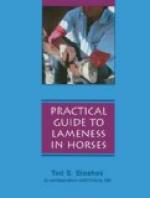As a rule, the reduction of this form of luxation is not difficult. The patella may be pushed inward and into position without manipulation of the leg. Retention of the patella in position is a difficult problem. Bandaging is considered impractical and is not ordinarily done in this country. Benard, according to Cadiot and Almy, recommends bandaging with a heavy piece of cloth in which an opening is made through which the patella is allowed to protrude, and by turning such a bandage snugly about the stifle several times, the patella is held in position. This bandage should be kept in place for about ten days.
In young and rachitic animals outdoor exercise and a good nutritive ration for the subject are indicated. Hypophosphites in assimilable form may be beneficial, and vesication of the patellar region contributes to recovery.
Where extreme luxation is present in both stifles, the prognosis is unfavorable. In such cases, degenerative changes may exist and in some instances the ligaments are so diseased and elongated that regeneration is impossible. Williams[46] reports a case where bilateral “floating” (outward) luxation was present and extensive degeneration changes affected the articulation.
In subjects suffering frequent dislocation of the patella (habitual luxation) it is possible in some cases, to prevent its occurrence or at least to minimize the distress occasioned by momentary luxation, by keeping the animals in wide stalls so that “backing” is unnecessary. In some nervous subjects that seem to be suffering from cramp of the crural muscles, the difficulty and pain of their being backed out of narrow stalls, accentuates the nervousness. Sudation and restlessness are manifested and the subject presents a clinical picture of distress and fear of a painful ordeal. In some cases of this kind, complete recovery takes place by the time animals are five or six years of age. One should avoid keeping such subjects in narrow stalls. Preferably patellar desmotomy should be performed that relief may be obtained at once.
Luxations attending some cases of influenza recover promptly when subjects are kept comfortably confined in roomy box-stalls. The administration of stimulative medicaments such as nux vomica and the application of an active blistering agent to the patella serve to hasten recovery. Dislocations in such cases are often bilateral and they are usually momentary. Reduction occurs spontaneously, as a rule, and the subjects are not occasioned much distress if they are kept quiet for a few days.
Chronic Gonitis.
Etiology and Occurrence.—Chronic inflammation of the stifle joint is met with following acute synovitis due to strains and concussion. It is an ailment which affects heavy horses and particularly animals that are kept at work on paved streets, but this does not explain its existence in animals that are not subjected to work likely to cause concussion. Berns[47] considers rheumatism a probable cause of gonitis and, as he states, the dropsical form of affection of this joint is not ordinarily attended with manifestations of inconvenience to the subject. Gonitis is often bilateral and its onset is insidious in many instances.




